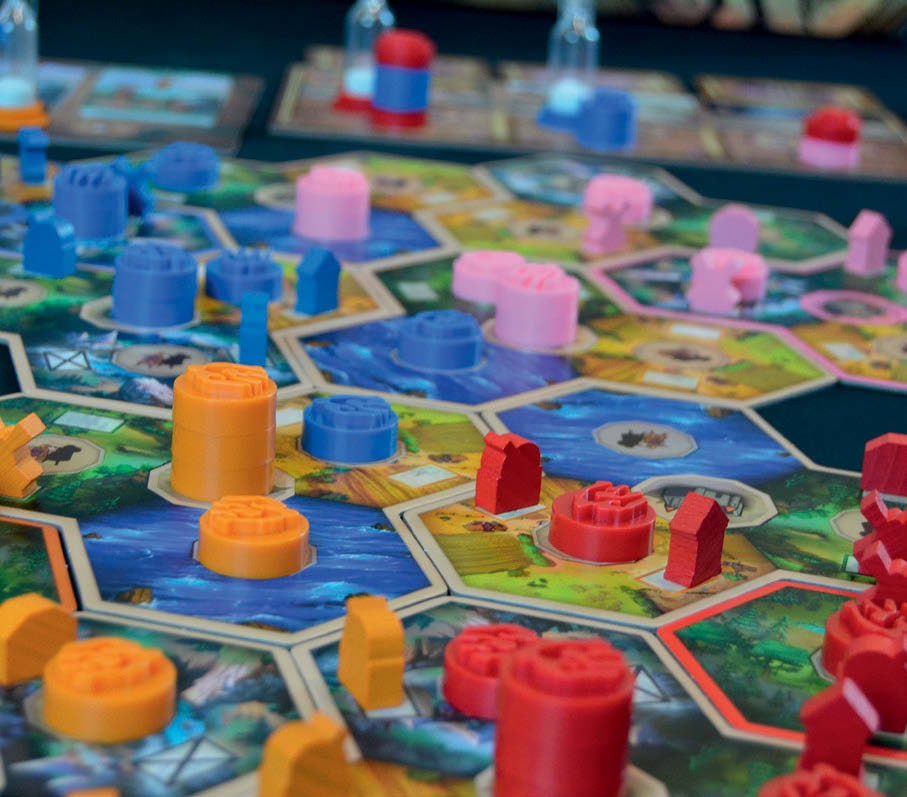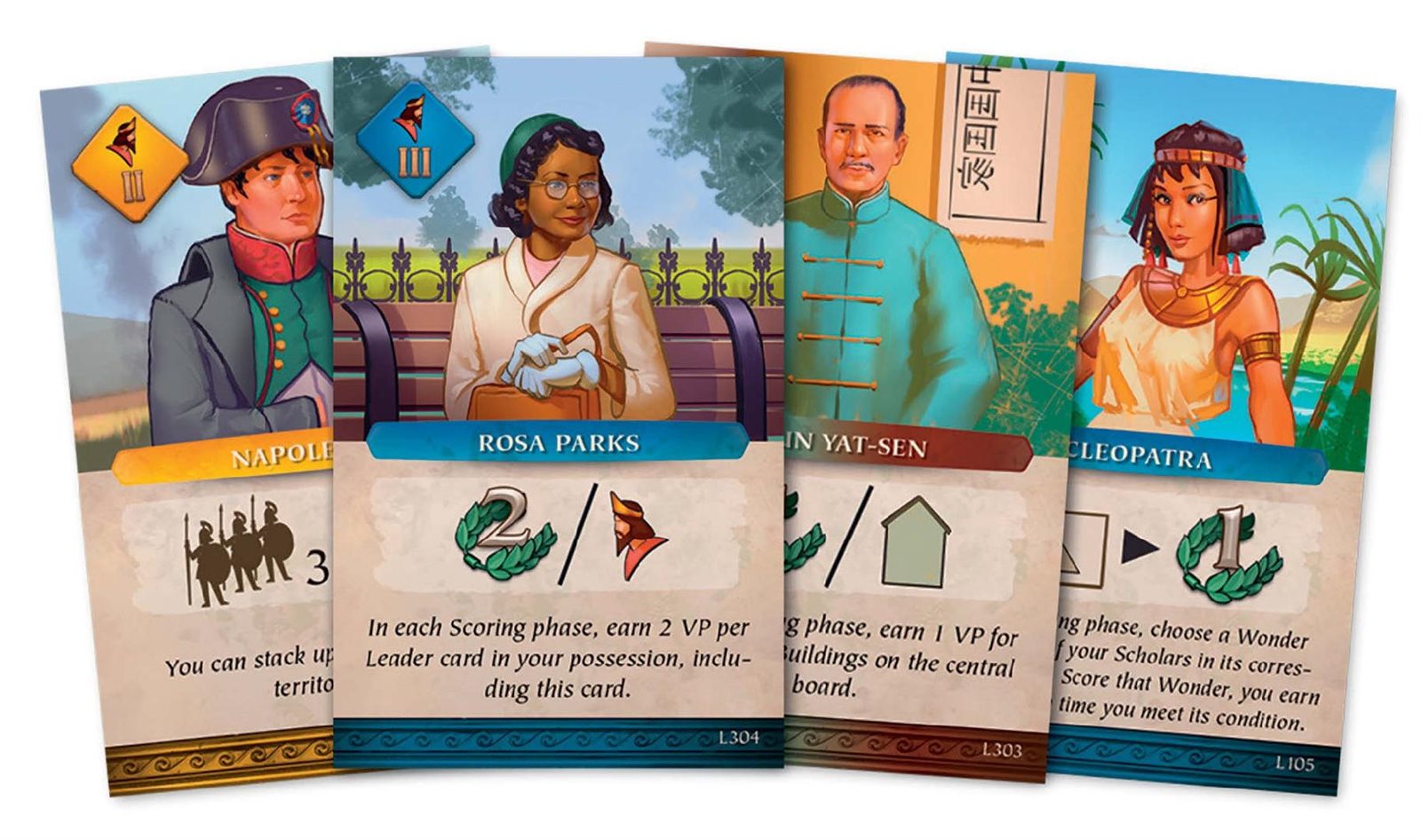Your empire best strike back
TIME OF EMPIRES
Designer: David Simiand & Pierre Voye | Publisher: Pearl Games
Let’s cut to it, after all, the sand timers are running. Time of Empires is the best game I’ve played this year. It has literally everything you want from a big, hearty, empire-building board game, while killing off the unwanted aspects. There’s drama, there’s chaos, there’s puzzles and strategy, there’s the 20 minutes afterwards where everyone talks about their tactics, and what they’re going to do next time they play. It’s brilliant, and you should go buy yourself a copy right now.
It’s a civilisation building game where you, as a player, need to generate resources to pay for powers, build building, raise an army, claim territory, influence leaders and even build wonders. Each time you play a power you need to pay for it with resources, which are generated from two worker placement slots on your board. Once the cost is paid you can play it, generating whatever benefit it describes – more resources, units, scholars and so on. That card can now be built, with a separate action, which takes further resources. When you finally build that card, you take one of the little wooden meeples of a building (a windmill, a barracks and so on) and place it somewhere you control on the main board. You’ve just uncovered something on your player board, and now, the next time you generate that resource (or units, or scholars) you create more of that thing. This fun bit of engine building must be balanced against the expansion of your empire on the main board via military might, and end of round points. Once you create soldiers (these are stackable plastic chips) you place them on the board somewhere you control, and another action can be taken to move them. Move them into territory with someone’s piece, and you’ll start a very simple war where – we assume – armies run at each other with the pointy end of a stick and the team with the most soldiers wins. You remove as many from your stack as there are enemies, and remove those You remove as many from your stack as there are enemies, and remove those too, with a last man standing rule for control of the hex. If you roll into someone’s province where they have a building, you burn it down, and put it in a pile on your personal board. Then there’s the scholars, who can be used to build wonders (end of round points) where you only get the points if you have the majority, and leaders, which confer ongoing powers into the next rounds.

Now, all of this sounds pretty straightforwardly 4X. Very simplified and cut down maybe. A gateway Eurogame that’ll bring in loads of new players. To this I say, yes it is, but also, it’s all played in real time. The workers you’re placing are sand timers, and you’ve got two. You play them, and then, when they’re run through, you can flip them on to another worker placement space to take any of the actions above.
And it is the perfect chaos of a huge empire building game.
The fun of a big civilisation or empire building game is those long turns where you think about whether you’re about to invade your table neighbour’s region, breaking a hundred-years long pact that had brought prosperity to the region – because it looks like Jeremy is going to gain even more victory points through grain this turn. Then Time of Empires explodes the bit where Jeremy got to think about grain silo placement for 15 minutes on his turn, despite it being obvious that he’d place it exactly where he placed it. Instead, you’re probably not going to have a chance to see what exactly Jeremy is up to, and instead go with your gut that he’s probably a bit of a threat and take him down anyway. You might see another player take control of a leader that you’d previously invested in, and now you need to make the choice – switch your next move to winning that back, or somehow take petty revenge elsewhere.

The whole game is a headspinningly fast. At two players you’re in a tight duel for the space and end game points where every movement away from the current tug of war is analysed with suspicion. Can you trust that they’re really interested in that ongoing power from a leader or the end of round points? Or is it just a distraction so they can roll out another attack into your homelands.
The war that happens on the table between players – with a single-sided conflict resolution – means that you’ll take your eye away from the board for a moment and find you’ve lost territories and building when you look back. It contains all of those elements of a big, chunky 4X game, but at hyper speed.
And with this comes the very simple app, which acts as a timer, score sheet, soundtrack, and a trigger for when you can build scholars (an end game scoring sort of unit). As I mentioned in the interview last month, this app is very distracting to parents of young children, as a baby’s cry is the sign that a new scholar has been born. It’s a genius bit of design as the injection of levity from what is quite an intense game of peering around the table to take optimal moves very quickly almost always get a bit of a laugh.
Everything about this game is designed to plug you into some fuzzy decision making. You’ll regret a third of every turn you have in the game, but it won’t matter, because everyone else is making their decisions shooting from the hip as well.
At the end of just over half an hour (assuming you have a little break between each round) you’ll have a winner, have destroyed and rebuild empires, and most importantly created a new enemy to hold a grudge against for the next time round. And as with all of our favourite games like this, that next time will be right now.
CHRISTOPHER JOHN EGGETT
WE SAY
Pure, unadulterated fun in the span of half an hour. The 4X game for the masses.
WHAT’S IN THE BOX?
◗4 Common boards
◗4 Player boards
◗4 Leader tiles
◗12 Terrain tiles
◗8 Sand timers
◗16 Sand timer caps (rubber)
◗80 Population tokens
◗80 Building tokens
◗48 Resource tokens
◗118 Cards
TRY THIS IF YOU LIKED GALAXY TRUCKER…
Time of Empires is a great step up from Galaxy Trucker but with a deeper and more rewarding range of strategies to uncover.